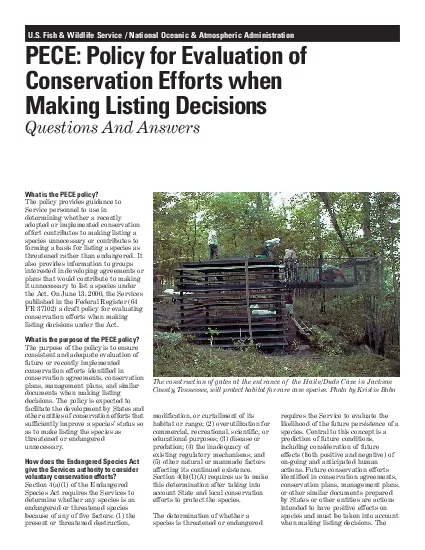

PECE Policy for Evaluation of Conservation Efforts when Making Listing Decisions Questions And Answers What is the PECE policy The policy provides guidance to Service personnel to use in determining w ID: 864820
Download Pdf The PPT/PDF document "US Fish Wildlife Service National Ocea..." is the property of its rightful owner. Permission is granted to download and print the materials on this web site for personal, non-commercial use only, and to display it on your personal computer provided you do not modify the materials and that you retain all copyright notices contained in the materials. By downloading content from our website, you accept the terms of this agreement.
1 U.S. Fish & Wildlife Service / National
U.S. Fish & Wildlife Service / National Oceanic & Atmospheric Administration PECE: Policy for Evaluation of Conservation Efforts when Making Listing Decisions Questions And Answers What is the PECE policy? The policy provides guidance to Service personnel to use in determining whether a recently adopted or implemented conservation effort contributes to making listing a y or contributes to forming a basis for listing a species as threatened rather than endangered. It mation to groups interested in developing agreements or y to list a species under the Act. On June 13, 2000, the Services published in the Federal Register (64 FR 37102) a draft policy for evaluating conservation efforts when making listing decisions under the Act. What is the purpose of the PECE policy? The purpose of the policy is to ensure future or recently implemented conservation efforts identified in conservation agreements, conservation plans, management plans, and similar documents when making listing decisions. The policy is expected to other entities of conservation efforts that sufficiently improve a species’ status so as to make listing the species as threatened or endangered unnecessary. How does the Endangered Species Act give the Services authority to consider Section 4(a)(1) of the Endangered Species Act requires the Services to determine whether any species is an endangered or threatened species uction, The construction of gates at the entrance of the Haile/Duds Cave in Jackson County, Tennessee, will protect habitat for rare cave species. Photo by Kristin Bobo modification, or curtailment of its utilization for commercial, recreational, scientific, or y mechanisms; and (5) other natural or manmade factors this determination after taking into account State and local conservation efforts to protect the species. The determination of whether a species is threatened or endangered requires the Service to evaluate the likelihood of the future persistence of a species. Central to this concept is a prediction of future conditions, on-going and anticipated human actions. Future conservation efforts identified in conservation agreements, conservation plans, management plans, or other similar documents prepared by States or other entities are actions intended to have positive effects on species and must be taken into account when making listing decisions. The PECE policy is intended to guide theServices in the evaluation of suchvoluntary conservation efforts.What does the policy require theServices to consider when evaluatingThe policy explains that in order todetermine that a conservation effortcontributes to making listing a speciesy,a basis for listing as threatened ratherthan endangered, the Services mustfind that the conservation effort issufficiently certain to be implementedcriteria that the Services will use todetermine whether a conservationeffort is sufficiently certain to beimplemented and effective. Forexample, the criteria require that alllaws and regulations necessary toimplement the conservation effort bein place and that the parties that willvation effortprovide a high level of certainty thatthey will obtain the necessary funding.Does the policy specify what t
2 ype ofconservation efforts will make lis
ype ofconservation efforts will make listing aConservation efforts are expected totake many forms and address a largevariety of issues that are specific to thefocus species, landscape, and partiesprovide guidance for determining thelevel of conservation or the types ofconservation efforts needed to makelisting unnecessary.does not provide guidance fordetermining when parties should enterinto agreements or when avation effort should be includedin an agreement or plan. The policyonly identifies criteria that theServices will use in determiningwhether a conservation effort issufficiently certain to be implementeda species unnecessary or contributes toforming a basis for listing a species asthreatened rather than endangered.Are there any benefits to the states orother entities to engage in conservationThe Endangered Species Act makes itillegal for any person to “take”(includes harass, harm, pursue, huntshoot, would, kill, trap, capture, orcollect; or to attempt any of these),import or export, ship in interstate, or sell or offer for sale ininterstate or foreign commerce anymit.Consequently, listing of a species mayresult in restrictions on land uses andten interestedin finding alternative ways ofprotecting declining species that’s permitting processes.Conservation agreements or plans canprovide these benefits if they providehabitats to make listing unnecessary.In addition, when conservation effortsare initiated early, before a species islisted under the ESA, these efforts aremost effective and efficient inving species and habitat.Initiating or expanding conservationefforts before a species and its habitatlikelihood that simpler, more cost-effective conservation options will stillbe available to States and otherentities, and that conservation willultimately be successful.How does a State ensure that aconservation agreement or plan will beTolist species, we encourage States tobegin development of conservationagreements or plans before a specieshas declined to the point where thevices are considering it forcandidate status. The Services arecommitted to working closely with aand supporting conservationagreements or plans that eliminate thethreats that otherwise may lead to aspecies requiring protection under theEndangered Species Act.Because the circumstancessurrounding each declining species willvary, the Services cannot specifycriteria for inclusion in eachvation agreement or plan thatwill necessarily remove the need to liststandard for measures necessary toconserve particular species. However,the policy does identify criteria thatthe Services will use to evaluatewhether a conservation effort issufficiently certain to be implementedy. Such criteriainclude identification of explicity to implementthe conservation effort, parameters tobe used to demonstrate achievement ofobjectives, and standards for theparameters by which progress will bemeasured, among others. Meeting thecriteria ensures that conservationefforts are carefully planned andU. S. Fish and Wildlife ServiceEndangered Species Program4401 N. Fairfax Drive, Room 420Arlington, VA 22203703/358 2105 National Marine Fisheries ServiceRoom 136581315 East West HighwaySilver Spring, MD 20910September 200